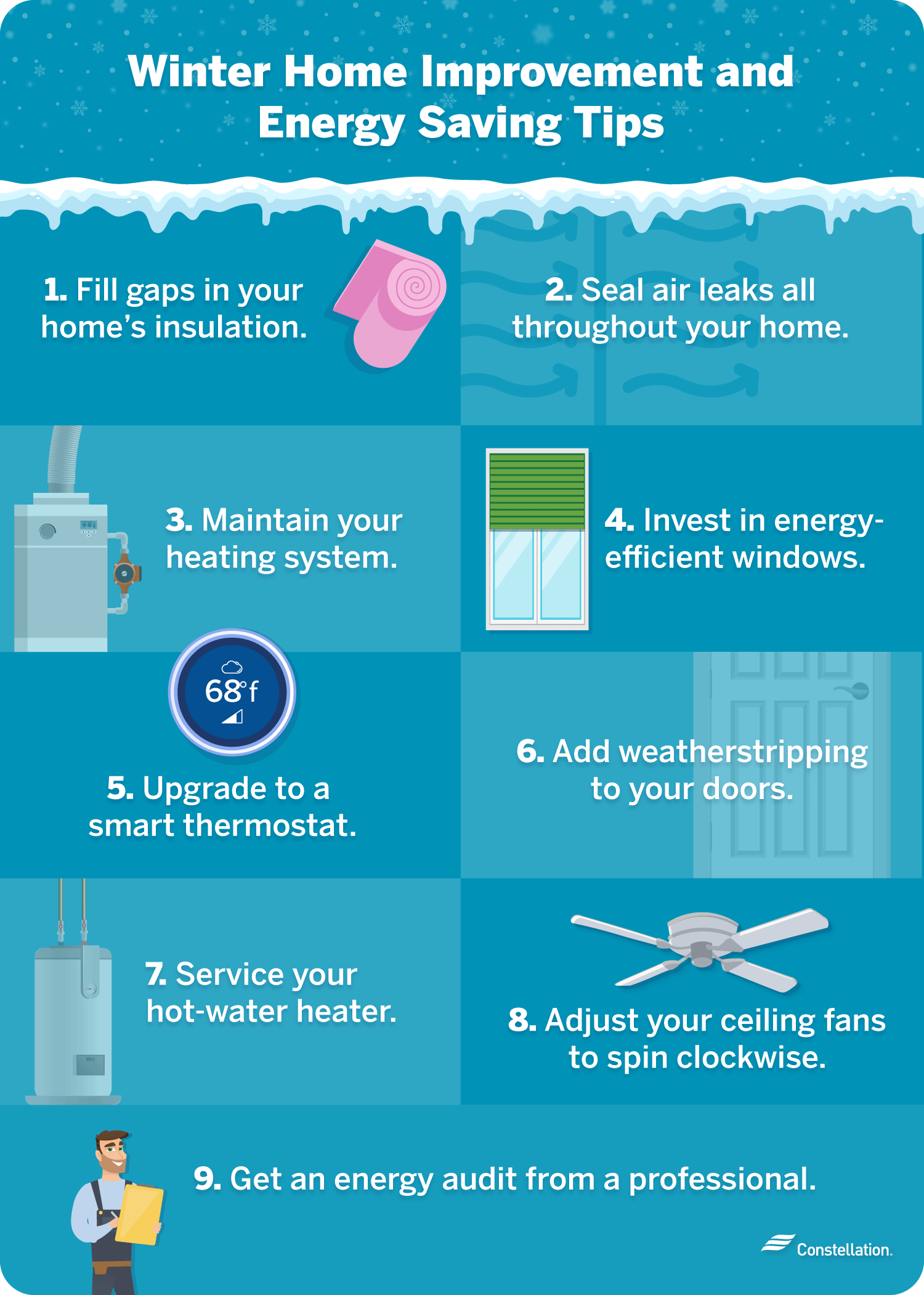
- Category:
Home Energy Savings -
Last updated:
January 9, 2025
9 Winter Home Improvements to Save Energy
Heating your house during the colder months can be costly. Luckily, there are many winter home energy saving tips that can help you stretch your dollar. The following energy-saving house projects are relatively simple to do, and many are inexpensive. But even those requiring a bigger effort and budget can quickly return savings that may make them worthwhile.

1. Fill gaps in your home’s insulation.
One of the most basic tips for saving energy in winter is fixing insulation gaps that let frigid drafts in. Because heat rises, start by checking the insulation in your attic. The condition of your roof also matters. By choosing energy-efficient roofing, you can help keep your home cool during the summer and warm in the winter.
Work your way to your basement, touching walls, floors and ceilings. Even on a cold day, they should be dry and warm. If not, you may need more wall insulation.
Simple home energy-saving improvements for winter like these can lower your bill and add value to your home.
2. Seal air leaks throughout your home.
Doors, windows, vents and places where plumbing, cable or electric services enter your home often have gaps that allow heat to escape. Finding air leaks in your home is critical.
One easy DIY home energy saving project is sealing these gaps with caulk, weatherstripping or more insulation. Weatherstripping (and door sealing) can be done a number of different ways, depending on the job.
For windows, inexpensive plastic film is easy to install and can stop serious drafts. You may also want to consider heavy drapes. They do more than add beauty; they’re a tried-and-true additional layer of insulation.
3. Maintain your heating system.
A dirty system with worn parts has to work harder to produce heat, and that’s a waste of energy. Like a car after a tune-up, your heating system is more likely to run efficiently and trouble-free if you keep it in peak condition. Energy saving tips for winter months often include installing new filters at the start of the season. And maintaining your boiler or furnace — ensuring that all moving parts are clean and well-oiled and that pipes, flues and ducts are free of debris — will have your heating system running efficiently into spring and beyond.
Consider doing your own heating system maintenance or signing up for professional home service protection that includes regular inspections and tune-ups. The money you save on energy may well pay for the cost. You’ll also reduce the risk that your furnace will go out during a cold snap.
4. Invest in energy-efficient windows.
Replacing your windows is a major energy-saving project for the home but doing so can really pay off. It may not be cheap to do, but since old windows can let heat out of the house, replacement costs can quickly be recovered in the form of lower energy bills.
Frames are every bit as important as the glass when it comes to energy-efficient windows. Look for materials that don’t conduct heat and that are insulated. For the glass, look for double panes and special coatings that add an insulating layer and reflect heat.
If you can’t afford new windows, be sure your old windows don’t have gaps and leaks. If you find any, caulk and weatherstripping can stop the heat loss. Storm windows, solar film and plastic sheeting can also help keep the cold out. And heavy drapes are among the best DIY winter energy-saving tips you can follow.
5. Upgrade to a smart thermostat.
If you want to go high tech, consider installing a smart thermostat as your next home energy efficiency DIY project. You can connect it to your Wi-Fi and program it to lower the temperature in your home when you’re at work or sleeping. And it can be controlled remotely from your phone.
You can also fine-tune energy use by turning down the heat in certain rooms when the sun is shining in. Set the smart thermostat to sense the most efficient heating program that balances saving energy with being comfortable.
Smart home upgrades like a modern, high-tech thermostat add value to your home as they save you money.
6. Add weatherstripping to your doors.
Here’s a tip for saving energy in winter: Pay attention to your doors. Doors can leak heat even when they’re closed. An easy DIY winter energy-saving tip is to add weatherstripping to doors that lead outside, to the basement or to your attic. The weatherstripping stops drafts that waste energy.
Attach the weatherstripping around the door frame and finish with a door sweep along the bottom edge of the door to stop the flow of cold air that commonly seeps in. When you weatherize your home for winter with weatherstripping, you are adding an inexpensive improvement that increases comfort and saves money. And even though it’s an energy saving tip for winter months, you may also save money during the heat of the summer by keeping cooler air from escaping.
7. Service your hot-water heater.
Like your furnace, your water heater works hard in winter months. A good home energy-saving improvement for winter is to schedule annual service to make sure it’s working efficiently and that worn parts are replaced before they break.
More tips for saving energy in winter with your water heater:
- Replace filters regularly. Just like with your HVAC system, new, clean filters make your water heater run more smoothly.
- Turn down the thermostat. You’ll still have plenty of hot water for showers, but your hot water heater will run more efficiently.
- Wrap your water heater. Specially designed blankets add a layer of insulation that’s fire resistant and helps prevent heat from dissipating into the surrounding air.
8. Adjust your ceiling fans to spin clockwise.
Because warm air rises, heat can pool around your ceiling, which means your heating system has to work harder to keep you from feeling chilly closer to the floor. Ceiling fans can be used in winter to move that warm air back down to you and spare your heating system the extra work. Adjusting your ceiling fan to run clockwise creates an updraft, drawing the cold air up from the floor and pushing the warm air down.
If you have high ceilings, you could save quite a bit on the cost of heating your home by using fans.
9. Get an energy audit from a professional.
Which winter home energy-saving tips will give you the greatest benefit? If you’re not an energy expert, sometimes it can be hard to figure out on your own. Knowing where you might need more insulation and finding areas that are leaking heat isn’t always easy.
Fortunately, you can call an expert. Professional energy audit specialists have the tools and know-how to show you how to make your home more energy-efficient. They can tell you which energy saving projects for the home are most important and urgent, and help you make decisions that balance need and cost.
Not all winter home energy-saving tips will make sense for your household every year. But it pays to review them annually. Even in the most efficient homes, systems wear out and insulation breaks down.
Whether you just add a little weatherstripping or start a major energy-saving house project like replacing the windows, keeping up with maintenance and making seasonal changes is smart. By taking control of your energy usage, you’ll feel confident all winter long that you’re not wasting energy to heat your home.




